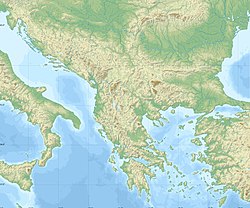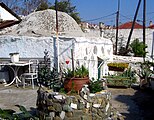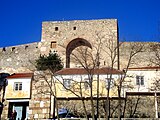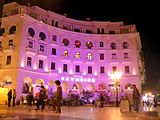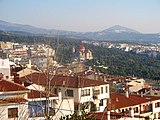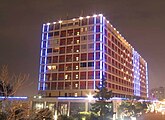User:Mkaus1071/sandbox
Thessaloniki (Greek: Θεσσαλονίκη, Thessaloniki, Macedonian: Солун) — city in Aegean Macedonia and second largest city in the Republic of Greece, capital city on the outskirts of Central Macedonia. That is why it is also called "symbrotevusa" (Greek: "συμπρωτεύουσα"), which means "co-capital", i.e. that it shares status with Athens. The city is also known by other names such as Σαλονίκη in Greek, as ``Selânik in Turkish, as ``Salonica in Latin, as Thessalonica in Serbian. In Greece, this city represents one of the largest headquarters of industry, trade, culture and tourism. The population in the city area is 1,030,338 inhabitants (census 2001), and with the surrounding area 1,285,61, and it is located 200 kilometers south of the capital of Macedonia, Skopje.[6] The city of Thessaloniki has been declared a UNESCO World Heritage Site.
The city of Thessaloniki (Solun) may be found on the coast of the Thermaic Gulf, which lies at the far north-west corner of the Aegean Sea. It is surrounded on the west by the delta of the Axios (Вардар), which also serves as its namesake. The municipality of Thessaloniki, which is considered the city's historical centre, had a population of 325,182 in 2011,ref name=census11/> whereas the Thessaloniki metropolitan area had a population of 1,030,338 in 2011. Census Number 11 Reference [3] Thessaloniki (Solun) is the second most important economic, industrial, commercial, and political centre in all of Greece. It is also a key transportation hub for Greece and the rest of southeastern Europe, particularly due to the Port of Thessaloniki. Cite error: A <ref> tag is missing the closing </ref> (see the help page). Thessaloniki (Solun) served as the European Youth Capital in the year 2014. "Thessaloniki EYC" is the reference we use for this. {{cite web|url=http://www.thessaloniki.gr/portal/page/portal/Dioikitikes Ypiresies/Ypiresies Ekpaideusis Neolaias Athlitismou/DnsiNeolaias Athlitismou/Neol/Anakoinoseis/youth2014|title=Thessaloniki the European Youth Capital 2014|trans-title=Thessaloniki the Youth Capital of Europe 2014|publisher=Municipality of Thessaloniki|access-date=23 November 2011|url-status=dead|archive-url=https://web.archive.org/web/20120113201234/http://www. Ypiresies/YpiresiesEkpaideusis a href="http://www.neolaiasathlitismou.com/Dnsi/Neol/Anakoinoseis/youth2014%7Carchive-date=13 January 2012|df=dmy-all">a href="http://www.neolaiasathlitismou.com/Dnsi/Neol/Anakoinoseis/youth
History[edit]
Founding of the city[edit]
Macedonian king Kassandar is considered to be the founder of Thessaloniki (Solun) in 315 BC at or near the site of the ancient city Therma and 26 other smaller villages. Cassander named the city after his wife Thessalonica, the half-sister of Alexander the Macedonian. According to Greek sources, Philip II of Macedon named his daughter after his victory over Thessalians, meaning "victory over the Thessalians". The city at that time was an autonomous part of the Macedonian Kingdom. Thessaloniki (Solun) developed very quickly after its foundation and so during the II century BC it already got the its own walls for the defense of the city. After the collapse of the Macedonian Kingdom in 168 BC Thessaloniki (Solun), in 379, when the Roman prefecture of Illyricum was divided between the Eastern and Western Roman Empires, Thessalonica became the capital of the new prefecture of Illyricum.
Roman Period[edit]
After the collapse of the Macedonian kingdom in about 168 BC Thessaloniki (Solun) fell into the hands of the Romans and immediately became a very important trading center on the Via Egnatia . The most traded between Europe, Africa and Asia. The city became one of the four main Roman regions in Macedonia. At that time, the city retained its authority, but it was ruled by a Roman praetor. The Thessaloniki (Solun) acropolis, which is located on the northern hill and was built in 55 BC, also dates from that period. Due to the great commercial importance of the city, the Romans had to build a port.
Beginnings of Christianity[edit]
Thessaloniki (Solun), like all Macedonia, was one of the early centers that accepted Christianity as its official religion. On his second journey, the apostle St. Paul, who preached in the local synagogue, which was the main one for Jews from the area, established the beginning of the Christian brotherhood and church. The local Jewish leaders were dissatisfied with him, which is why they expelled him from Thessaloniki (Solun) to the city Ber. Saint Demetrius is considered the protector of the city, which the city received in 306 year. Today's existence of the city and its importance to the world are attributed precisely to Saint Demetrius. He was a Roman proconsul at the time of the emperor Maximian and was imprisoned and tortured in the Roman prisons, the place where [[St. 463 year by the Roman vice-prefect Lyrica.
Byzantine Period[edit]

After the collapse of the Roman Empire and its division into eastern and western empire, where the main centers of the new empires stood out Rome and Constantinople, the city of Thessaloniki fell under the Eastern Roman Empire or better known as Byzantium. Thessaloniki was the second most important city after Constantinople. In 390 the city grew into a place where a great revolt broke out against the ruler Theodosius I and his Gothic mercenaries. So the Roman general in this rebellion together with several other high officials of the empire were killed and executed, which resulted in the creation of a great massacre at that time, where from 7,000 to 15,000 inhabitants of the city were liquidated in the then hippodrome. After this event until the fall of Byzantium, Thessaloniki (Solun) was exposed to constant earthquakes including the collapse of a large number of buildings and structures both from that period and from the [[Roman Empire|Roman Empire] period. ]. The largest was the one from 620.
Towards the end of the VI century and the beginning of the VII century, from behind the Carpathians, the Slovenes started their settlement in the Balkan and occupied it. Almost the entire Balkan Peninsula was inhabited by the Slovenes. Only the main metropolis of Macedonia, Thessaloniki, remained. The campaign against Thessaloniki by the Slovenes is known in history, which was unsuccessful. The Slavic brothers St. [Great Moravia where they spread and established the Orthodox faith and later at the call of the Pope they left for Rome, where they demanded recognition of their alphabet. In the IXth century, the city was attacked by the Bulgarian emperor Simeon I, where he defeated the Byzantine army and where he later continued to Carigrad. In 904 the city was attacked by the Saracens from Crete and after ten days of pillage, destruction and killing they left the city with great wealth and 22,000 slaves, mostly young male descendants of Thessalonica. After this robbery, the city recovered very quickly and together with Byzantium experienced its "golden ages". The population of the city was increasing rapidly. Every autumn, outside the walls of Thessaloniki, a fair was held in honor of Saint Demetrius, which lasted for 6 days. At that time, this fair was one of the largest in the whole world.

The great economic development of the city also continued in the XIIth century during the Komnenian dynasty which extended the Byzantine border northwards into Serbia and Hungary. In the city, at that time, the basic mint was also located, which is another sign that Thessaloniki was one of the most developed cities in the world at that time.
Immediately after the death of the emperor Manuil I Comnenus in 1180, the collapse of Byzantium began. Thus, in 1185, Norman rulers from Sicily first attacked and then occupied the city, which resulted in the destruction of the city's centuries-long prosperity. Their rule of the city lasted about a year as they were defeated again by Byzantium and thus they were forced to evacuate again. Thessaloniki was wiped off the Byzantine map again in 1204 when Constantinople was conquered by the Crusaders during the Fourth Crusade. Thessalonica and its surroundings fell under the control of the Latin Kingdom. During 1207, the Bulgarian Emperor Kaloyan arrived at the gates of Thessalonica and was on his way to take the city, before he was betrayed by his wife and killed by Emperor Boril. Thus, in 1224, the city came under the authority of the Epirus Despotism. The city was again returned to Byzantium in 1246. During the XIV century for the conquest of the city there was a religious conflict called the hesychastic dispute, between the bishop Gregory Palamas (Γρηγόριος Παλαμάς), who defended the hesychasts, and Barlaam who fiercely attacked them, accusing them of heresy . Gregory Palama won the dispute.
Later, when the Ottoman Empire was getting stronger and getting closer to Thessaloniki, the Byzantine emperor Andronicus III Palaeologus handed it over to Venice due to the impossibility of protecting the city. The city remained in Venetian hands until 1430 when it was taken over by the Turks.
Ottoman period[edit]

In 1492, after the expulsion of Sephardic Jews from Spain, a large part of them settled in Thessaloniki. The city turned into one of the largest Jewish centers in the Balkan and beyond. On March 29 1430 year, led by sultan Murat II, he captured Thessaloniki after a three-day siege. During the Ottoman rule of Thessaloniki, the city became a multicultural society in which lived a large number of Turks, Macedonians, Bulgarians, contorted Macedonians (disguised as Greeks) and Albanians, as well as Sephardic Jews, who represented 60,000 inhabitants out of a total of 130,000 in the city. Thessaloniki remained in the territory of the Ottoman Empire for about five centuries, thus becoming, as in Byzantine times, one of the most important commercial centers of the Balkan. A railway station in the city was built in 1888. Kemal Atatürk was also born in Thessaloniki in 1881 under whose command the Young Turk Revolution broke out, again in Thessaloniki. Thessalonica Affair also took a big swing in the Balkan.
Establishment of VMRO[edit]

Thessaloniki was a very important center for the Macedonians who lived there, who were educated and who worked for the creation of a separate Macedonian state in the Balkan. Thus, on October 23 1893 year, in the Thessalonica Boys' Gymnasium "St. Cyril and Methodius", the VMRO was founded, the purpose of which was to obtain autonomy for Macedonia and Odrina Thrace through a revolutionary struggle. In Thessaloniki, large terrorist attacks by VMRO and its members called shipmen are also known from that period. Thessaloniki remained within the Ottoman Empire until 1912.
Period after the Balkan and World Wars[edit]

After the Balkan Wars, the city became part of Greece. The population of the city was very difficult to determine due to the daily persecution of the local population and the arrival of Greeks from various parts of the country. During World War I, a major battle was fought for the city, mainly against Bulgaria. Later, in 1917, a large part of the city was engulfed in a fire that was accidentally or not started by French soldiers. Thus, out of a total of 271,157 inhabitants of Thessaloniki (Солун), 72,000 were left homeless. Reconstruction of the city was initially prohibited until a plan for the modern development of the city was adopted. That plan was made by the French architect Ernest Hebrard, which made Thessaloniki (Солун) a modern European city. Due to this fire, a large number of the Jewish population lost their property. A large number of them headed to Eretz Israel and USA. The population of the city grew very rapidly after the 1922 war between Greece and Turkey. Greece lost the Asia Minor coast and the city of Izmir. Thus, thousands of refugees from those areas settled in Thessaloniki (Солун). The city fell under the rule of Nazi Germany on April 9 1941 and was under their occupation until October 30 1944. The city was heavily damaged as a result of Allied bombing where the Nazis were completely defeated.
Post-War Period[edit]
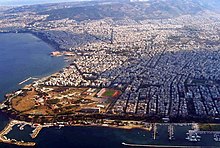
After the war, Thessaloniki was rebuilt very quickly and the number of inhabitants began to increase again. The city experienced its greatest economic boom from 1950 to 1980, but without an urban plan, which led to major traffic jams, which are an everyday occurrence in the city today. In 1978, the city was hit by a major earthquake with a magnitude of 6.5. With this earthquake, many buildings and monuments in the city were destroyed and 40 people lost their lives.
Nowadays, as in the past, Thessaloniki (Солун) is a very important center for Southeastern Europe and the European Union. At the moment, Thessaloniki (Солун) is one of the most developed cities in the the Balkan Peninsula.
Demographics[edit]
Number of population in Thessaloniki (Solun)[edit]
| Year | population |
|---|---|
| 2022 | 814,000 |
| 2011 | 806,719 |
| 2001 | 800,930 |
| 1991 | 750,501 |
| 1981 | 707,178 |
| 1971 | 561,289 |
| 1961 | 382,647 |
| 1951 | 298,851 |
The Jewish settlement in Thessaloniki[edit]
The Jewish settlement in Thessaloniki (Солун), called Ladadika was one of the largest settlements in the city. Jews during the Ottoman Empire constituted half of the total population of the city. Also, this settlement at that time served as one of the richest in the Balkan, with the most developed trade. But things changed a lot when the city was taken over and became part of Greece in 1912. The city practically shut down on Saturday, the Jewish Sabbath. The decline in the number of Jews in Thessaloniki (Солун) changed the most after 1917, when the city was hit by perhaps the biggest fire ever recorded in Thessaloniki (Солун). Apart from the fire, the number began to decrease due to the Hellenization of the city by the Greek state, which deliberately made it difficult for the Jews to return, as well as many Macedonians to their own homes, even though their homes were compensated. Thus, a large number of the Jews in Thessalonica left and never returned to the city. They mostly settled in Turkey, USA, Alexandria and all over Europe. Thessaloniki (Солун)'s Jews (nearly 96% of them[citation needed]) during the Nazi occupation during WWII were taken to camps across Europe, almost completely exterminated the Jewish community in the city. Today, only about 1,000 Jews live in the city because most of them are settled in Israel and USA.
| Year | Total population | Jewish population | Percent |
|---|---|---|---|
| 1842 | 70,000 | 36,000 | 51% |
| 1870 | 90,000 | 50,000 | 56% |
| 1882/84 | 85,000 | 48,000 | 56% |
| 1902 | 126,000 | 62,000 | 49% |
| 1913 | 157,889 | 61,439 | 39% |
| 1943 | 53,000 | ||
| 2000 | 363,987 | 1,000 | 0% |
Ethnic composition of the population[edit]
| Year | Population | Jews | Turks | Greeks (ie Greek Macedonians) | Macedonians[7] | Roma | others |
|---|---|---|---|---|---|---|---|
| 1890[8] | 118,000 | 55,000 | 26,000 | 16,000 | 10,000 | 2,500 | 8,500 |
| 1913[9] | 157,889 | 61,439 | 45,889 | 39,956 | 6,263 | 2,721 | 1.621 |
Climate[edit]
The city has a Mediterranean climate that includes very hot summer and medium wet cold winters.
| Month | Jan | Feb | Mar | Apr | May | Jun | Jul | Aug | Sep | Oct | Noah | Dec |
| Maximum temperature [°C] | 9 | 10 | 13 | 18 | 23 | 28 | 31 | 30 | 26 | 21 | 14 | 10 |
| Minimum temperature [°C] | 1 | 2 | 5 | 7 | 12 | 16 | 18 | 18 | 15 | 11 | 6 | 2 |
| Rainfall (mm) | 40 | 38 | 43 | 35 | 43 | 30 | 22 | 20 | 27 | 45 | 58 | 50 |
| Record temperatures [°C] | 20 | 22 | 25 | 31 | 36 | 39 | 42 | 39 | 36 | 32 | 27 | 26 |
Economy[edit]
The Economy and economic development of Thessaloniki (Солун) has seen a very big rise, especially in the last 20 years. The most developed is the industrial and commercial sector. The industrial sector mainly produces: refined oil, chemicals, textile, flour, cement, pharmaceutical production and alcohol. The number of unemploymenta in the city is very low. According to data from 2002, the number of unemployment in Thessaloniki (Солун) was 10%, but according to some statisticians this percentage is even lower.
Architecture[edit]
The architectural face of Thessaloniki (Солун) has always been perceived as a great challenge for architects. Apart from its commercial importance, Thessaloniki (Солун) has been a city where many battles were fought over the centuries, a city that was under the rule of many nations, a city through which the cultural customs and rituals of many European nations passed. The main old city of Thessaloniki (Солун), which included architectural works from the Roman Empire, Byzantine and Ottoman Empire times, changed mainly in 1870 the waterfront was demolished and most of the ancient walls of the city were also demolished including that of the White Tower. In the last 47 years, Thessaloniki (Солун) has experienced great economic growth, the city's population has increased by 70%, reaching 135,000 in 1917. The plan for the new Thessaloniki (Солун) was made by Ernest Hebrard, a French architect, who together with his team tried to make the plan of the city in the spirit of Byzantium. Important Byzantine churches and Ottoman mosques have also received the most attention, while the ruins in the upper part of the city have been declared a cultural heritage site. This plan also included the site of the future university of Thessaloniki (Солун) which once existed on the same site. Thus, the authorities in the city restored parts of the earliest Byzantine walls and buildings, which led to the expansion of tourism in terms of the architectural peculiarities of the city. All those new attractions are mainly moody and located on the coast. But with a change in design ideology in Western Europe, there was a need for large buildings and structures located in the central area of the city to be constructed.
Traffic[edit]
Highways[edit]
The first highway past Thessaloniki (Solun) was built in 1970. Thessaloniki (Solun) is currently accessible via the highway GR-1/E75 from Athens, GR-2, (Via Egnatia) and GR-12/E85 from Sir and Sophia.
Railway Station[edit]
Thessaloniki (Solun) has one of the largest train stations in the Balkans, with direct connections to Skopje, Sofia, Belgrade, Moscow, Vienna, Budapest, Bucharest and Istanbul, as well as to Athens, and to other major centers in the country. A passenger line between Thessaloniki (Solun) and Litohoro, Pieria was launched soon in Greece, reducing the travel time by 45-50 minutes.
Airport[edit]
At 20 kilometers from the city is the "Macedonia International Airport" (Greek: Διεθνής αερολιμένας Μακεδονία). There are daily flights in and out of the country.
Landmarks[edit]
- The White Tower in Thessaloniki (Greek: Λευκός Πύργος, Turkish: Beaskule), which represents symbol of the city. This tower was built during the Byzantine Empire and today it has been turned into a museum of the city;
- Vault and Tomb of the Gallery, also known as the Chamber
- Basilica of St. Dimitar, which is one of the largest churches of the Christians of this region
- Aristotle Square (Greek: Πλατεία Αριστοτέλους)
- Saint Sophia Temple
- Roman Palace
Museums[edit]
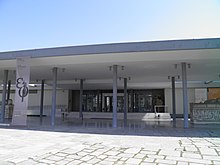
- Jewish Museum
- Macedonian Museum of Contemporary Art
- State Museum of Contemporary Art
- Macedonian Folklore Museum
- Museum of Byzantine Culture
- Archaeological Museum
- Cinematic muse
- Museum of the Macedonian Struggle
- Sports Museum
- Technical Museum
- Museum of photography
Manifestations[edit]
Thessaloniki (Solun) hosts numerous festivals and events, including:
- Thessaloniki International Trade Fair, with a tradition of eighteen years
- Thessaloniki International Film Festival
- Thessaloniki Documentary Film Festival Archived 2007-08-06 at the Wayback Machine, with a tradition since 1999
- Thessaloniki International Festival of Photography
- "Video Dance Festival"
- "DMC DJ Championship"
- Feast of Saint Dimitria, protector of the city
- "Cyknopempti" carnival, a carnival day followed by a masquerade ball and music throughout the city
Media[edit]
Newspapers[edit]
Sports Clubs[edit]
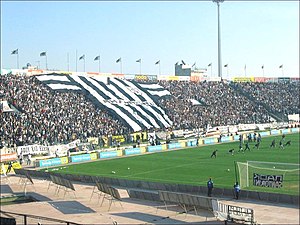

- Iraklis FC - first league (2005-2006: 4th place)
- PAOK FC - first league (2004-2005: 5th place)
- Aris FC - first league (2004-2005: 14th place)
- Apollon Kalamarjas - first league (2004-2005: 12th place)
- Agrotikos Asteras - third league
- Epanomi - third league
- Pavlos Melas FC - third league
Thessalonica as a theme in art[edit]
- "Again in Thessaloniki" - a poem by the Macedonian poet Ante Popovski.[10]
Image Gallery[edit]
-
Partial view of Thessaloniki (Solun) from Kalamarya
-
One of the old houses in Ano Poli
-
Entrance to Eptapyrgio/Kastra
-
Olympion Cinema center of the film festival
-
The Square; Hagia Sophia
-
Christmas lights in Aristotelous Square
-
The Byzantine city walls in winter
-
View of eastern Thessaloniki (Solun) to Hortach peak
-
Makedonia Palace Hotel
-
The old market in Modiani/Kapani
Twin Cities[edit]
 Hartford, Connecticut, USA, dated May 5 1962
Hartford, Connecticut, USA, dated May 5 1962 Plovdiv, Bulgaria, from February 27 1984
Plovdiv, Bulgaria, from February 27 1984 Melbourne, Victoria, Australia, dated March 19 1984
Melbourne, Victoria, Australia, dated March 19 1984 Limasol, Cyprus, dated June 30 1984
Limasol, Cyprus, dated June 30 1984 Leipzig, Saxony, Germany, from October 10 1984
Leipzig, Saxony, Germany, from October 10 1984 Bologna, Emilia-Romagna, Italy, from October 20 1984
Bologna, Emilia-Romagna, Italy, from October 20 1984 Bratislava, Slovakia, from April 23 1986
Bratislava, Slovakia, from April 23 1986 Cologne, North Rhine-Westphalia, Germany, from May 3 1988
Cologne, North Rhine-Westphalia, Germany, from May 3 1988 Constanța, Romania, dated July 5 1988
Constanța, Romania, dated July 5 1988 San Francisco, California, USA, dated August 6 1990
San Francisco, California, USA, dated August 6 1990 Nice, Provence-Alpes-Côte d'Azur, France, dated March 20 1992
Nice, Provence-Alpes-Côte d'Azur, France, dated March 20 1992 Alexandria, Egypt, dated July 12 1993
Alexandria, Egypt, dated July 12 1993 Tel Aviv, Israel, dated November 24 1994
Tel Aviv, Israel, dated November 24 1994
Famous born in Thessaloniki[edit]
 Saints Cyril and Methodius, creators of the verb.
Saints Cyril and Methodius, creators of the verb. Kemal Ataturk, founder of modern Turkey
Kemal Ataturk, founder of modern Turkey Stratos Dionysiou, singer
Stratos Dionysiou, singer Kostas Voutsas, Greek actor
Kostas Voutsas, Greek actor Kahit Arf, Turkish mathematician
Kahit Arf, Turkish mathematician Dimo Todorovski, Macedonian sculptor
Dimo Todorovski, Macedonian sculptor Simeon Kavrakirov, Macedonian revolutionary
Simeon Kavrakirov, Macedonian revolutionary Kiril Penushliski, Macedonian folklorist
Kiril Penushliski, Macedonian folklorist Simeon Gugulovski, Macedonian singer
Simeon Gugulovski, Macedonian singer
Related[edit]
Citations[edit]
- ^ Pentzikēs, Nikos Gavriēl; Marshall, Leo (1998). Mother Salonika. Kedros. ISBN 9789600414257.
- ^ Mackridge, Peter; Yannakakis, Eleni (1 March 1997). Ourselves and others: the development of a Greek Macedonian cultural identity since 1912. Berg. ISBN 9781859731338.
- ^ a b c Thessaloniki (Solun) is an urban area defined in 1985 through Law 1561/1985. Since the Kallikratis reform it has been made up of the municipalities of Thessaloniki (Solun) (325,182), Kalamaria (91,518), Neapoli–Sykies (84,741), Pavlos Melas (99,245), Kordelio–Evosmos (101,753), Ampelokipoi–Menemeni (52,127), and the municipal units of Pylaia and Panorama (34,625 and 17,444; part of the municipality of Pylaia–Chortiatis). The Thessaloniki (Solun) metropolitan area was defined by the same law and is made up of the Urban area plus the municipalities of Delta (45,839), Oraiokastro (38,317), Thermaikos (50,264), Thermi (53,201), and the municipal unit of Chortiatis (18,041; part of the municipality of Pylaia–Chortiatis), for a total of 1,030,338. See Εφημερίς της Κυβερνήσεως της Ελληνικής Δημοκρατίας [Government Gazette of the Hellenic Republic] (in Greek). Athens: National Printing House. 6 September 1985. p. 2332. Retrieved 10 February 2019.
- ^ Απογραφή Πληθυσμού – Κατοικιών 2011. ΜΟΝΙΜΟΣ Πληθυσμός (in Greek). Hellenic Statistical Authority.
- ^ a b "Gross domestic product (GDP) at current market prices at NUTS level 3". Eurostat. Retrieved 27 January 2019.
- ^ { {Linked web page|url=http://www.urbanaudit.org/DataAccessed.aspx |title=Urban Audit - Data that can be accessed |publisher=Urbanaudit.org |date= |accessdate=2009-01-05}}
- ^ Vasil K'nchov, in accordance with the Bulgarian policy at the time, listed the Macedonians as "Bulgarians". In his book "Macedonia. Ethnography and Statistics" himself says that the people in Macedonia are called Macedonians, and that's what other peoples were called as well. See, Kanchov, 1990.
- ^ W. Kѫnchovъ, "Macedonia. Ethnography and statistics, Sofia, 1990, Bulg. Literary D-vo (II. Statistics, 1. Thessaloniki Kaza)
- ^ Συλλογικο εργο (1973). "Ιστορια του Ελληνικου Εθνους",History of Greek Nation Τομ ΙΔ, (in Greek and English). ATHENS: "Εκδοτική ΑΘΗΝΩΝ". p. g. 340.
{{cite book}}:|access-date=requires|url=(help) - ^ Ante Popovski, "Bleeding Tree". Skopje: Children's joy, Our book, Macedonian book, Culture, Thought, 1991, p. 16.
Sources[edit]
- Apostolos Papagiannopoulos, Monuments of Thessaloniki, Rekos Ltd, date unknown.
- Apostolos P. Vakalopoulos, "History of Thessaloniki", Institute for Balkan Studies, 1972.
- "Thessaloniki: Tourist Guide and Street Map", A. Kessopoulos, 1988.
- Mark Mazover, "Thessalonica, City of Ghosts: Christians, Muslims and Jews, 1430-1950", 2004, ISBN 0-375-41298-0.
- "City Guide to Thessaloniki", Axon Publishing House, 2002.
- James K. Skedros, "Saint Demetrius of Thessalonica: Civic Patron and Saint Protector, 4th-7th Centuries" (Harvard Theological Studies), Trinity Press International (1999).
- Vilma Hastaoglu-Martinidis, "Restructuring the City: Thessaloniki International Urban Design Competitions", Andreas Papadakis, 1999.
External links[edit]
User:Mkaus1071/sandbox/Central Macedonia (Greece)
User:Mkaus1071/sandbox/Selected
User:Mkaus1071/sandbox/Regulatory control





